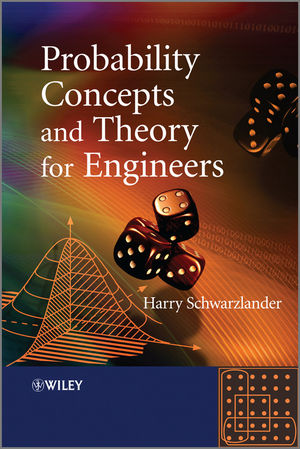|
Textbook
Probability Concepts and Theory for EngineersISBN: 978-0-470-74855-8
Hardcover
622 pages
February 2011, ©2010
 |
||||||
Introduction.
Part I. The Basic Model.
Part I Introduction.
Section 1. Dealing with ‘Real-World’ Problems.
Section 2. The Probabilistic Experiment.
Section 3. Outcome.
Section 4. Events.
Section 5. The Connection to the Mathematical World.
Section 6. Elements and Sets.
Section 7. Classes of Sets.
Section 8. Elementary Set Operations.
Section 9. Additional Set Operations.
Section 10. Functions.
Section 11. The Size of a Set.
Section 12. Multiple and Infinite Set Operations.
Section 13. More About Additive Classes.
Section 14. Additive Set Functions.
Section 15. More about Probabilistic Experiments.
Section 16. The Probability Function.
Section 17. Probability Space.
Section 18. Simple Probability Arithmetic.
Part I Summary.
Part II. The Approach to Elementary Probability Problems.
Part II. Introduction.
Section 19. About Probability Problems.
Section 20. Equally Likely Possible Outcomes.
Section 21. Conditional Probability.
Section 22. Conditional Probability Distributions.
Section 23. Independent Events.
Section 24. Classes of Independent Events.
Section 25. Possible Outcomes Represented as Ordered k-Tuples.
Section 26. Product Experiments and Product Spaces.
Section 27. Product Probability Spaces.
Section 28. Dependence Between the Components in an Ordered k-Tuple.
Section 29. Multiple Observations Without Regard to Order.
Section 30. Unordered Sampling with Replacement.
Section 31. More Complicated Discrete Probability Problems.
Section 32. Uncertainty and Randomness.
Section 33. Fuzziness.
Part II Summary.
Part III. Introduction to Random Variables.
Part III. Introduction.
Section 34. Numerical-Valued Outcomes.
Section 35. The Binomial Distribution.
Section 36. The Real Numbers.
Section 37. General Definition of a Random Variable.
Section 38. The Cumulative Distribution Function.
Section 39. The Probability Density Function.
Section 40. The Gaussian Distribution.
Section 41. Two Discrete Random Variables.
Section 42. Two Arbitrary Random Variables.
Section 43. Two-Dimensional Distribution Functions.
Section 44. Two-Dimensional Density Functions.
Section 45. Two Statistically Independent Random Variables.
Section 46. Two Statistically Independent Random Variables-Absolutely Continuous Case.
Part III Summary.
Part IV. Transformations and Multiple Random Variables.
Part IV Introduction.
Section 47. Transformation of a Random Variable.
Section 48. Transformation of a Two-Dimensional Random Variable.
Section 49. The Sum of Two Discrete Random Variables.
Section 50. The Sum of Two Arbitrary Random Variables.
Section 51. n-Dimensional Random Variables.
Section 52. Absolutely Continuous n-Dimensional R. V.’s.
Section 53. Coordinate Transformations.
Section 54. Rotations and the Bivariate Gaussian Distribution.
Section 55. Several Statistically Independent Random Variables.
Section 56. Singular Distributions in One Dimension.
Section 57. Conditional Induced Distribution, Given an Event.
Section 58. Resolving a Distribution into Components of Pure Type.
Section 59. Conditional Distribution Given the Value of a Random Variable.
Section 60. Random Occurrences in Time.
Part IV Summary.
Part V. Parameters for Describing Random Variables and Induced Distributions.
Section 61. Some Properties of a Random Variable.
Section 62. Higher Moments.
Section 63. Expectation of a Function of a Random Variable.
Section 64. The Variance of a Function of a Random Variable.
Section 65. Bounds on the Induced Distribution.
Section 66. Test Sampling.
Section 67. Conditional Expectation with Respect to an Event.
Section 68. Covariance and Correlation Coefficient.
Section 69. The Correlation Coefficient as Parameter in a Joint Distribution.
Section 70. More General Kinds of Dependence Between Random Variables.
Section 71. The Covariance Matrix.
Section 72. Random Variables as the Elements of a Vector Space.
Section 73. Estimation.
Section 74. The Stieltjes Integral.
Part V Summary.
Part VI. Further Topics in Random Variables.
Part VI Introduction.
Section 75. Complex Random Variables.
Section 76. The Characteristic Function.
Section 77. Characteristic Function of a Transformed Random Variable.
Section 78. Characteristic Function of a Multidimensional Random Variable.
Section 79. The Generating Function.
Section 80. Several Jointly Gaussian Random Variables.
Section 81. Spherically Symmetric Vector Random Variables.
Section 82. Entropy Associated with Random Variables.
Section 83. Copulas.
Section 84. Sequences of Random Variables.
Section 85. Convergent Sequences and Laws of Large Numbers.
Section 86. Convergence of Probability Distributions and the Central Limit Theorem.
Part VI Summary.
Appendices.
Notation and Abbreviations.
References.
Subject Index.



